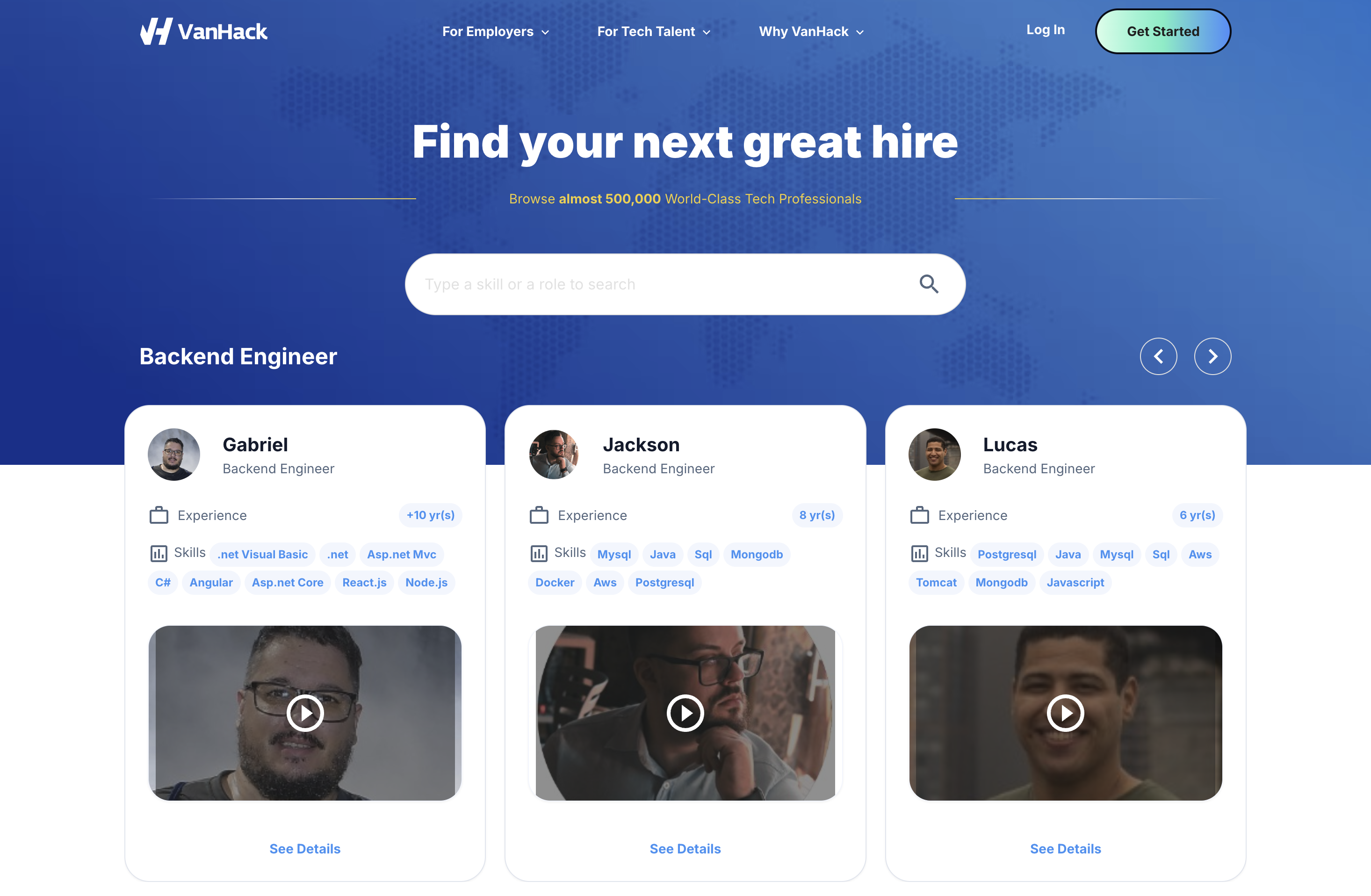US companies often struggle with the high costs and fierce competition for Next.js talent, which can slow down growth. With Next.js developer salaries averaging $143,532 globally, many startups find it tough to attract skilled professionals. Latin America offers a practical solution, providing access to talented developers at lower costs, with the added benefit of similar time zones and cultural alignment. This guide shares five effective strategies to hire Next.js developers from LATAM and explains how specialized tools can help you save money while building a strong team. Ready to get started? Explore talent with VanHack now.
Why Choose Latin America for Next.js Developers?
Next.js has become a go-to framework for companies using React for server-side rendering and static site generation to boost performance and SEO. In the US, high salaries and competition from big tech firms make hiring a challenge, often stretching budgets and delaying projects.
Latin America stands out as a cost-effective option without sacrificing quality. Senior developers in countries like Mexico, Colombia, Argentina, and Chile earn between $45,000 and $66,000 per year, far below the US average of over $120,000 for similar roles. This can mean savings of 40 to 60 percent for your company.
Cost isn’t the only advantage. Many LATAM developers speak English well, have experience working remotely, and bring technical skills shaped by international projects. Those working with US firms often earn two to three times the local rate, allowing you to offer attractive pay while still keeping expenses down. Ready to tap into this talent pool? These strategies will guide you. Connect with developers at VanHack.
5 Practical Strategies to Hire Next.js Developers in LATAM
1. Use Specialized Recruitment Platforms for Better Results
Finding skilled Next.js developers through general job boards or in-house recruiters can be inefficient. These developers need expertise in both React frontend and server-side rendering, which generic platforms or internal teams may not fully understand, leading to a flood of unqualified applicants.
Specialized recruitment tools focus on tech talent and offer in-depth vetting. They assess technical skills and cultural fit before you even see a resume, saving you time and effort.
VanHack stands out as a reliable option for hiring tech professionals.

The platform provides detailed profiles with video intros to gauge communication, AI-driven technical interviews to test problem-solving, and coding test scores for objective insights. Their AI tool, Vanna, delivers a shortlist of three to five pre-vetted candidates tailored to your needs.
Key steps to implement:
- Pick platforms focused on global tech talent with strong LATAM connections. Ensure they test for Next.js and related skills.
- Check that vetting includes technical exams and communication reviews. Look for clear scoring and feedback on candidates.
- Measure success by tracking time to shortlist (target under five business days), candidate quality, and interview-to-offer rates. Find qualified developers with VanHack.
2. Tailor Compensation to the LATAM Market
Attracting top Next.js talent in LATAM means understanding local pay rates and offering packages that stand out against both regional opportunities and other US companies. Your goal is to provide fair pay that benefits both the candidate and your budget.
Senior developers in LATAM earn around $54,000 annually, though rates vary by country and expertise. Those skilled in Next.js may expect higher pay due to growing demand from US firms.
Key steps to implement:
- Research shows senior React.js developers in LATAM earn between $56,400 and $62,400 yearly. Use this as a starting point for Next.js roles, adjusting for niche skills.
- Offer pay that’s two to three times the local rate but 30 to 50 percent less than US equivalents. Budget $75,000 to $95,000 for senior talent, a significant saving compared to US salaries up to $232,000.
- Add value with perks like remote work stipends ($1,000 to $2,000 yearly), learning budgets, health benefits, and flexible time off. These extras appeal to LATAM candidates without raising base costs much.
- VanHack’s subscription plan, Vanna, costs $3,000 monthly for unlimited hires, or you can opt for a success-fee model. Hire efficiently with VanHack.
3. Build a Clear and Respectful Interview Process
Hiring internationally requires a thoughtful interview process to navigate cultural differences, language gaps, and time zone challenges. For tech roles like Next.js, you need to evaluate both coding skills and the ability to collaborate with your team.
A respectful approach ensures candidates can show their best while aligning with your expectations. Many LATAM developers bring valuable insights and experience that can enrich your team.
Key steps to implement:
- Be upfront about interview stages, technical topics, and time needs. Share sample challenges to set clear expectations.
- Use a three-step process: a 30-minute cultural fit call, a 60-minute technical test, and a 45-minute chat with senior staff. This builds candidate confidence while giving you a full picture.
- Prioritize clear technical explanations over perfect English. Ask candidates to explain their approach to common issues to test communication.
- Use tools like CodePen or Replit for live coding, and video calls with screen sharing or virtual whiteboards for discussions.
VanHack simplifies this with video intros for early communication checks and AI-driven technical assessments. This lets your team focus on deeper fit and skills during interviews.
4. Set Up Remote Next.js Teams for Success
Integrating remote developers takes careful planning for both technical setup and team connection. Next.js roles often involve complex systems, so new hires need a clear path to understand your tools and goals.
Your aim is to help them move from outside contributors to core team members who grasp your product’s purpose and technical foundation.
Key steps to implement:
- Send a welcome kit with branded gear, internet support, and system docs. Add small local touches like snacks or swag for a personal connection.
- Provide pre-set development environments with specific configs and guides on coding standards.
- Create a 30-60-90 day plan, starting with basic tasks, moving to optimizations, and ending with bigger contributions. Assign projects to teach your stack.
- Pair hires with mentors for guidance. Set up daily check-ins for the first week, then weekly, plus Slack channels for casual questions. Plan for time zone overlap.
- Track progress with metrics like time-to-first-commit and feature delivery speed. Aim for meaningful code contributions within a month.
5. Support Relocation with Full Global Mobility Services
While remote work is common, some companies prefer on-site talent for key projects or collaboration. International relocation, however, comes with legal, logistical, and personal hurdles that need careful handling.
For tech roles, visa processes often require proof of unique skills, making expert support essential to avoid delays.
Key steps to implement:
- Develop policies for visa sponsorship, housing, family support, and cultural integration. Be clear about timelines, as visas can take 6 to 18 months.
- Work with immigration experts familiar with tech roles to explain the specialized nature of the work to authorities.
- Handle logistics like flights, temporary homes, banking, healthcare, and tech setup, including VPN access.
- Start relocation planning 6 to 12 months early. Allow remote work during visa waits to maintain productivity.
VanHack provides full Global Mobility support, managing visas and logistics like housing or schools at no extra cost. This removes stress so you can hire talent seamlessly with VanHack, whether remote or on-site.
Comparing Platforms for Sourcing Next.js Developers
|
Platform Feature |
VanHack |
Toptal |
|
|
Vetting Depth |
Deep AI tests, video intros, coding scores |
Extensive technical screenings, live interviews, code challenges |
Self-reported skills, optional assessments |
|
Talent Pool Focus |
Global senior tech, strong LATAM focus |
Global freelance, contractor-focused |
Broad professional network |
|
Business Model |
Subscription or success-fee, direct hire |
Contractor markup, marketplace model |
Job postings, recruiter tools |
|
Relocation Support |
Full Global Mobility team included |
None provided |
None directly offered |
How to Boost Your Next.js Hiring in LATAM
Beyond the main strategies, successful companies use extra tactics to improve hiring results in Latin America. These steps can elevate your recruitment approach.
Focus on ongoing relationships with the LATAM tech scene. Sponsor local events, support open-source projects, and stay connected with developers, even when not hiring. This builds a future talent pipeline and strengthens your reputation.
Encourage referrals from your LATAM hires. They often know other skilled developers in their networks, offering a trusted way to find great candidates.
Consider hybrid setups, bringing key developers on-site for planning or major projects while keeping most work remote. This balances cost savings with face-to-face collaboration.
Support learning by funding conferences, certifications, or training. LATAM developers value growth opportunities, and this investment can improve skills and loyalty.
Key Challenges to Avoid When Hiring in LATAM
Knowing common issues can help you sidestep mistakes that slow hiring or create team friction.
Don’t overlook communication needs. Even with good English, set clear guidelines for updates, documentation, and check-ins to keep everyone aligned.
Plan for time zone differences. Define shared working hours and response expectations to ensure smooth collaboration.
Address legal and tax rules upfront. International hiring varies by country, affecting contractor status, taxes, and compliance. Research thoroughly before offers.
Invest in cultural fit. Beyond skills, help LATAM hires understand your company’s style and expectations through proper onboarding.
Common Questions About Hiring Next.js Developers from LATAM
English skills vary, but many top LATAM developers working with US firms communicate well. Platforms like VanHack screen for this through videos and interviews, focusing on clear technical explanations over perfect speech.
Cost savings are significant. Senior LATAM developers earn $75,000 to $95,000 yearly with US companies, compared to $120,000 to $200,000+ in the US. This can cut costs by 30 to 50 percent for similar expertise.
Legal and tax rules depend on location and hiring setup. Key points include contractor versus employee status, tax obligations, and IP protection. VanHack offers compliance guidance, but consulting a lawyer ensures you meet all requirements.
Assess Next.js skills with practical tests and portfolio reviews, not just degrees. Many LATAM developers excel through self-learning or bootcamps. VanHack’s technical vetting provides clear skill insights.
Hiring timelines for remote roles are typically 4 to 8 weeks, covering sourcing, interviews, offers, and onboarding. Relocation adds 6 to 18 months for visas, though remote work during processing keeps things moving.
Conclusion: Grow Faster by Hiring Next.js Talent with VanHack
Finding Next.js developers doesn’t need to strain your budget or delay progress. Latin America offers a wealth of skilled talent, and with these strategies, you can build strong teams at lower costs than in the US.
Partnering with a platform that gets both tech needs and international hiring makes all the difference. VanHack offers AI matching, thorough vetting, and relocation support to simplify the process.
Whether you need a senior developer for performance tweaks, a full-stack engineer for new features, or a team for your roadmap, LATAM has the talent. The right approach and partner can help you connect with them quickly.
Don’t let a lack of developers hold you back. Use these strategies to build your team. Start hiring with VanHack and turn hiring challenges into a strength for your company.



